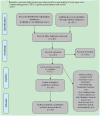X-ray repair cross-complementing group 1 (XRCC1) genetic polymorphisms and cervical cancer risk: a huge systematic review and meta-analysis
- PMID: 22984511
- PMCID: PMC3440401
- DOI: 10.1371/journal.pone.0044441
X-ray repair cross-complementing group 1 (XRCC1) genetic polymorphisms and cervical cancer risk: a huge systematic review and meta-analysis
Abstract
Background: Previous studies investigating the association between X-ray repair cross-complementation group 1(XRCC1) polymorphisms and cervical cancer (CC) risk has provided inconsistent results. The aim of our study was to assess the association between the XRCC1 gene Arg399Gln, Arg194Trp, Arg280His polymorphisms and risk of CC.
Methods: Two investigators independently searched the Medline, Embase, CNKI, and Chinese Biomedicine Databases for studies published before March 2011.Summary odds ratios (ORs) and 95% confidence intervals (CIs) for XRCC1 polymorphisms and CC were calculated in a fixed-effects model or a random-effects model when appropriate.
Results: Ultimately, 9, 5 and 2 studies were found to be eligible for meta-analyses of Arg399Gln, Arg194Trp and Arg280His, respectively. Our analysis suggested that the variant genotypes of Arg194Trp were associated with a significantly increased CC risk (Trp/Trp vs Arg/Arg, OR = 2.21, 95% CI = 1.60-3.06; Arg/Trp vs Arg/Arg, OR = 1.23, 95% CI = 1.02-1.49; dominant model, OR = 1.36, 95% CI = 1.14-1.63; recessive model, OR = 2.06, 95% CI = 1.51-2.82). For Arg280His polymorphism, no obvious associations were found for all genetic models. For Arg399Gln polymorphism, also no obvious associations were found for all genetic models. In the subgroup analyses by ethnicity/country, a significantly increased risk was observed among Asian, especially among Chinese. To get more precise evidences, adjusted ORs (95%CI) by potential confounders (such as age, ethnicity or smoking, etc) were also calculated for XRCC1 Arg399Gln and Arg194Trp, however, the estimated pooled adjusted OR still did not change at all.
Conclusion: This meta-analysis suggests that Arg194Trp polymorphism may be associated with CC risk, Arg399Gln polymorphism might be a low-penetrent risk factor for CC only in Asians, and there may be no association between Arg280His polymorphism and CC risk.
Conflict of interest statement
Figures





Similar articles
-
Association between X-ray repair cross-complementing group 1(XRCC1) Arg399Gln polymorphism and endometriosis: A systematic review and meta-analysis.Eur J Obstet Gynecol Reprod Biol. 2017 Nov;218:12-20. doi: 10.1016/j.ejogrb.2017.09.011. Epub 2017 Sep 14. Eur J Obstet Gynecol Reprod Biol. 2017. PMID: 28926725
-
The XRCC1 Arg194Trp polymorphism was associated with the risk of head and neck squamous cell carcinoma development: Results from a systematic review and meta-analysis.Cancer Rep (Hoboken). 2023 Mar;6(3):e1776. doi: 10.1002/cnr2.1776. Epub 2022 Dec 27. Cancer Rep (Hoboken). 2023. PMID: 36573562 Free PMC article.
-
XRCC1 Gene Polymorphisms and Breast Cancer Risk: A Systematic Review and Meta- Analysis Study.Asian Pac J Cancer Prev. 2016;17(S3):323-30. doi: 10.7314/apjcp.2016.17.s3.323. Asian Pac J Cancer Prev. 2016. PMID: 27165246
-
Association between polymorphisms in XRCC1 gene and treatment outcomes of patients with advanced gastric cancer: a systematic review and meta-analysis.PLoS One. 2014 Jan 21;9(1):e85357. doi: 10.1371/journal.pone.0085357. eCollection 2014. PLoS One. 2014. PMID: 24465544 Free PMC article.
-
X-ray repair cross-complementing group 1 (XRCC1) genetic polymorphisms and gastric cancer risk: A HuGE review and meta-analysis.Am J Epidemiol. 2011 Feb 15;173(4):363-75. doi: 10.1093/aje/kwq378. Epub 2011 Jan 7. Am J Epidemiol. 2011. PMID: 21216841
Cited by
-
Polymorphism of the DNA base excision repair genes in keratoconus.Int J Mol Sci. 2014 Oct 29;15(11):19682-99. doi: 10.3390/ijms151119682. Int J Mol Sci. 2014. PMID: 25356504 Free PMC article.
-
XRCC1 gene polymorphisms and the risk of differentiated thyroid carcinoma (DTC): a meta-analysis of case-control studies.PLoS One. 2013 May 22;8(5):e64851. doi: 10.1371/journal.pone.0064851. Print 2013. PLoS One. 2013. PMID: 23717668 Free PMC article.
-
Quantitative assessment of the associations between XRCC1 polymorphisms and bladder cancer risk.World J Surg Oncol. 2013 Mar 7;11:58. doi: 10.1186/1477-7819-11-58. World J Surg Oncol. 2013. PMID: 23496911 Free PMC article.
-
Variation in DNA Base Excision Repair Genes in Fuchs Endothelial Corneal Dystrophy.Med Sci Monit. 2015 Sep 21;21:2809-27. doi: 10.12659/MSM.894273. Med Sci Monit. 2015. PMID: 26388025 Free PMC article.
-
X-ray repair cross-complementing group 1 Arg194Trp polymorphism is associated with increased risk of lung cancer in Chinese Han population.Tumour Biol. 2013 Oct;34(5):2611-5. doi: 10.1007/s13277-013-0810-3. Epub 2013 May 8. Tumour Biol. 2013. PMID: 23653378
References
-
- Campalans A, Marsin S, Nakabeppu Y, O’connor TR, Boiteux S, et al. (2005) XRCC1 interactions with multiple DNA glycosylases: a model for its recruitment to base excision repair. DNA Repair (Amst) 4: 826–835. - PubMed
-
- Siciliano MJ, Carrano AV, Thompson LH (1986) Assignment of a human DNA-repair gene associated with sister-chromatid exchange to chromosome19. Mutat Res 174: 303–308. - PubMed
-
- Lamerdin JE, Montgomery MA, Stilwagen SA, Scheidecker LK, Tebbs RS, et al. (1995) Genomic sequence comparison of the human and mouse XRCC1 DNA repair gene regions. Genomics 25: 547–554. - PubMed
-
- Lindahl T, Wood RD (1999) Quality control by DNA repair. Science (80- ) 286: 1897–1905. - PubMed

